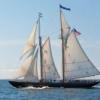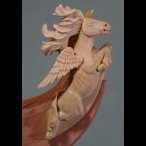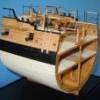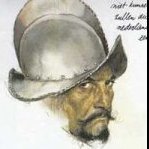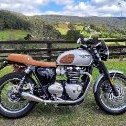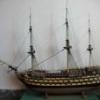-
Posts
655 -
Joined
-
Last visited
Reputation Activity
-
 rlb reacted to matiz in HMS EURYALUS by Matiz - FINISHED - scale 1:56
rlb reacted to matiz in HMS EURYALUS by Matiz - FINISHED - scale 1:56
Stern friezes, unfortunately for me, I have to use my left hand, which is not my hand, i'm using olive wood : :
-
 rlb got a reaction from Elia in US Brig Oneida 1809 by rlb - The Lumberyard - 1:48 scale - POF - Lake Ontario Warship
rlb got a reaction from Elia in US Brig Oneida 1809 by rlb - The Lumberyard - 1:48 scale - POF - Lake Ontario Warship
Thanks Ed. Yes, my shop has grown enormously from the first days. I cut the original masts from a billet with a jewelers saw, and spent hours (days) sanding them flat and square. Now it's a few minutes work. But I spend most of my time still with files, chisels, and sand paper.
I'm getting the fore and main tops ready. One of the tasks is making the futtock plates for those deadeyes I showed in the last post. I used the method described by David Antscherl in Vol. 4 of The Fully Framed Model.
Here is the test piece, and a bunch of square wire cut for the rest--
The wire I bought was supposed to be "dead soft" meaning it should be not spring back when bent, but I found I still had to heat it red hot to make it truly malleable. The wire pieces were bent around a drill--
They were then silver soldered at the "bottom" end. This would allow them to be bent back apart to insert the deadeyes. This shows a series of them ready to solder. You can just see the dab of solder paste about halfway along each piece--
.
That arrangement didn't work so well. Only three of the pieces soldered well, because when liquid, the silver followed gravity rather than the gap in the wire.
Turning the pieces this way worked better--
Here are some ready to be soldered, some successfully soldered and filed smooth, and some cut to length with a hole drilled for a hook--
All for now,
Ron
-
 rlb got a reaction from Wintergreen in US Brig Oneida 1809 by rlb - The Lumberyard - 1:48 scale - POF - Lake Ontario Warship
rlb got a reaction from Wintergreen in US Brig Oneida 1809 by rlb - The Lumberyard - 1:48 scale - POF - Lake Ontario Warship
Thanks Ed. Yes, my shop has grown enormously from the first days. I cut the original masts from a billet with a jewelers saw, and spent hours (days) sanding them flat and square. Now it's a few minutes work. But I spend most of my time still with files, chisels, and sand paper.
I'm getting the fore and main tops ready. One of the tasks is making the futtock plates for those deadeyes I showed in the last post. I used the method described by David Antscherl in Vol. 4 of The Fully Framed Model.
Here is the test piece, and a bunch of square wire cut for the rest--
The wire I bought was supposed to be "dead soft" meaning it should be not spring back when bent, but I found I still had to heat it red hot to make it truly malleable. The wire pieces were bent around a drill--
They were then silver soldered at the "bottom" end. This would allow them to be bent back apart to insert the deadeyes. This shows a series of them ready to solder. You can just see the dab of solder paste about halfway along each piece--
.
That arrangement didn't work so well. Only three of the pieces soldered well, because when liquid, the silver followed gravity rather than the gap in the wire.
Turning the pieces this way worked better--
Here are some ready to be soldered, some successfully soldered and filed smooth, and some cut to length with a hole drilled for a hook--
All for now,
Ron
-
 rlb got a reaction from Thukydides in US Brig Oneida 1809 by rlb - The Lumberyard - 1:48 scale - POF - Lake Ontario Warship
rlb got a reaction from Thukydides in US Brig Oneida 1809 by rlb - The Lumberyard - 1:48 scale - POF - Lake Ontario Warship
Thanks Ed. Yes, my shop has grown enormously from the first days. I cut the original masts from a billet with a jewelers saw, and spent hours (days) sanding them flat and square. Now it's a few minutes work. But I spend most of my time still with files, chisels, and sand paper.
I'm getting the fore and main tops ready. One of the tasks is making the futtock plates for those deadeyes I showed in the last post. I used the method described by David Antscherl in Vol. 4 of The Fully Framed Model.
Here is the test piece, and a bunch of square wire cut for the rest--
The wire I bought was supposed to be "dead soft" meaning it should be not spring back when bent, but I found I still had to heat it red hot to make it truly malleable. The wire pieces were bent around a drill--
They were then silver soldered at the "bottom" end. This would allow them to be bent back apart to insert the deadeyes. This shows a series of them ready to solder. You can just see the dab of solder paste about halfway along each piece--
.
That arrangement didn't work so well. Only three of the pieces soldered well, because when liquid, the silver followed gravity rather than the gap in the wire.
Turning the pieces this way worked better--
Here are some ready to be soldered, some successfully soldered and filed smooth, and some cut to length with a hole drilled for a hook--
All for now,
Ron
-
 rlb got a reaction from Elia in US Brig Oneida 1809 by rlb - The Lumberyard - 1:48 scale - POF - Lake Ontario Warship
rlb got a reaction from Elia in US Brig Oneida 1809 by rlb - The Lumberyard - 1:48 scale - POF - Lake Ontario Warship
I thought I would share my method for making deadeyes.
I made a bunch a long time ago for the main and fore shrouds, and half what I needed for the topmast and topgallant backstays. They were about 5mm and 4mm respectively. I made them using a method described in Underhill's book, and it worked out fine. The little jig is very fiddly to make. The method is shown from post #184-198 in this log.
However I now need 32 topmast shroud deadeyes at 3.5mm, and 12 more of the backstay deadeyes at 4mm. Partly because of the smaller size, and partly because I have better tools now, I wanted to try something that might be more precise.
This first batch is the 3.5mm set. I turned a squared piece of pear down to 3.5mm, and then scored it on the lathe with grooves for the futtock plates, and cut-very slight cut off grooves to help with parting them off with a saw. While the dowel was still on the lathe, one by one, I smoothed and rounded the outer edge, then cut it off. I didn't take pictures but here is the result--
You can see they have one smooth side, one rough side, and a groove. (Noticeable on one of the deadeyes standing on edge.)
Next I drilled a hole in a piece of scrap wood just under 2mm thick (the thickness the finished deadeye needs to be), filed the hole to to 3.5mm diameter, and glued it to another piece of scrap wood. This has a smaller hole drilled through it centered on the larger hole--
A deadeye fits very snuggly in the hole, the rough side slightly proud--
The rough edge is filed off flush with the surface of the wood--
I filed the one shown below just a bit more with a smaller file after taking the photo--
I then marked by eye the spots for the holes to be drilled--
And drilled them on a mill. I wasn't great at locating the drill precisely at the marks, so I tried drilling a couple by hand. I could get the drill in the mark very easily that way, but at that small size, my accuracy (keeping the pin vise vertical) wasn't good enough.
After some practice with the mill, I could locate the drill above the punched markings more quickly and pretty accurately--
The deadeye is then pushed out from behind--
And the flattened surface is rounded off with a file--
Here are two finished--
It took me about 5 before they started looking good. The first few had problems with my marking of the holes with the right spacing, as well as the stated problem with hand drilling them. I started with one spare, so I'll ponder whether the first are okay to use, or if I have to turn a few more blanks.
All for now,
Ron
-
 rlb got a reaction from usedtosail in US Brig Oneida 1809 by rlb - The Lumberyard - 1:48 scale - POF - Lake Ontario Warship
rlb got a reaction from usedtosail in US Brig Oneida 1809 by rlb - The Lumberyard - 1:48 scale - POF - Lake Ontario Warship
Thanks Ed. Yes, my shop has grown enormously from the first days. I cut the original masts from a billet with a jewelers saw, and spent hours (days) sanding them flat and square. Now it's a few minutes work. But I spend most of my time still with files, chisels, and sand paper.
I'm getting the fore and main tops ready. One of the tasks is making the futtock plates for those deadeyes I showed in the last post. I used the method described by David Antscherl in Vol. 4 of The Fully Framed Model.
Here is the test piece, and a bunch of square wire cut for the rest--
The wire I bought was supposed to be "dead soft" meaning it should be not spring back when bent, but I found I still had to heat it red hot to make it truly malleable. The wire pieces were bent around a drill--
They were then silver soldered at the "bottom" end. This would allow them to be bent back apart to insert the deadeyes. This shows a series of them ready to solder. You can just see the dab of solder paste about halfway along each piece--
.
That arrangement didn't work so well. Only three of the pieces soldered well, because when liquid, the silver followed gravity rather than the gap in the wire.
Turning the pieces this way worked better--
Here are some ready to be soldered, some successfully soldered and filed smooth, and some cut to length with a hole drilled for a hook--
All for now,
Ron
-
 rlb got a reaction from CiscoH in US Brig Oneida 1809 by rlb - The Lumberyard - 1:48 scale - POF - Lake Ontario Warship
rlb got a reaction from CiscoH in US Brig Oneida 1809 by rlb - The Lumberyard - 1:48 scale - POF - Lake Ontario Warship
Thanks Ed. Yes, my shop has grown enormously from the first days. I cut the original masts from a billet with a jewelers saw, and spent hours (days) sanding them flat and square. Now it's a few minutes work. But I spend most of my time still with files, chisels, and sand paper.
I'm getting the fore and main tops ready. One of the tasks is making the futtock plates for those deadeyes I showed in the last post. I used the method described by David Antscherl in Vol. 4 of The Fully Framed Model.
Here is the test piece, and a bunch of square wire cut for the rest--
The wire I bought was supposed to be "dead soft" meaning it should be not spring back when bent, but I found I still had to heat it red hot to make it truly malleable. The wire pieces were bent around a drill--
They were then silver soldered at the "bottom" end. This would allow them to be bent back apart to insert the deadeyes. This shows a series of them ready to solder. You can just see the dab of solder paste about halfway along each piece--
.
That arrangement didn't work so well. Only three of the pieces soldered well, because when liquid, the silver followed gravity rather than the gap in the wire.
Turning the pieces this way worked better--
Here are some ready to be soldered, some successfully soldered and filed smooth, and some cut to length with a hole drilled for a hook--
All for now,
Ron
-
 rlb reacted to Ebomba in US Brig Oneida 1809 by rlb - The Lumberyard - 1:48 scale - POF - Lake Ontario Warship
rlb reacted to Ebomba in US Brig Oneida 1809 by rlb - The Lumberyard - 1:48 scale - POF - Lake Ontario Warship
Ron ,you have a long way since those early ones , your tools are more sophisticated (and more expensive) but your quest for excellence remains the same, nice work and thanks for another lesson
Best
Ed
-
 rlb reacted to giampieroricci in HMS PEGASUS by giampieroricci - Scale 1:36 - Swan-Class Sloop from plans by David Antscherl & Greg Herbert
rlb reacted to giampieroricci in HMS PEGASUS by giampieroricci - Scale 1:36 - Swan-Class Sloop from plans by David Antscherl & Greg Herbert
here is my workshop in its current state....!
-
 rlb reacted to matiz in HMS EURYALUS by Matiz - FINISHED - scale 1:56
rlb reacted to matiz in HMS EURYALUS by Matiz - FINISHED - scale 1:56
Hi, and thanks to all
I generally use small chisels and gouges made from carbide shanks of broken cutters, or tailor's needles or hypodermic needles, I don't use motorized cutters, due to the smallness of the details, and I have a normal helmet with interchangeable lenses
-
 rlb got a reaction from Saburo in HMS Euryalus 1803 by rlb - 1:48 scale
rlb got a reaction from Saburo in HMS Euryalus 1803 by rlb - 1:48 scale
Thanks, JJ, druxey, Michel, and all those looking in, and liking. I appreciate the encouragement.
I took a leap of faith and followed Ed Tosti's lead from his Naiad books to start permanently gluing (well, there's always Isopropanol) each transom as it is fit. I really hate gluing anything until I feel confident about the whole assembly, but here goes--
The lowest transom is glued to the fashion timbers only, not to the sternpost, nor the fashion timbers to the deadwood--
I wasn't sure how the assembly would work as it's added to, but it's really quite simple. Here's the next transom in place on the sternpost, and the previous transom and fashion pieces sitting on the deadwood below it--
The fashion pieces/transom are then just slid up the deadwood, the lower transom fitted into its spot on the sternpost, and the upper transom test fitted with it's tenons into the fashion pieces--
If all is satisfactory (and believe me it took many tests and refinements to the second transom piece before it was satisfactory), then it is now glued to the fashion pieces--
Now on to the third (from the bottom) transom. This is the deck transom, and it must slope down and to the sides. I'm on the third try with the piece pictured here--
I took a different approach shaping this one. Instead of shaping it all over at the beginning, I just thinned it at the top (stern) and two lower forward ends, and made sure those fit, as they do in the photo above. Here is the piece showing the bottom--
And the top--
Once this fit was good, I then tapered and smoothed the top and bottom before gluing it into place--
So far so good. Remember the transoms are glued to the fashion pieces here, but not to the sternpost, and the transom/fashion piece assembly can be taken off . There is an enormous amount of fairing that will need to take place on the transoms and fashion pieces once it's all together. And I don't know how much of that I will do with it as a separate assembly, or glued finally to the deadwood and sternpost. We'll see. I am pleased so far with the general method.
All for now,
Ron
-
 rlb got a reaction from Trussben in HMS Euryalus 1803 by rlb - 1:48 scale
rlb got a reaction from Trussben in HMS Euryalus 1803 by rlb - 1:48 scale
Thanks, JJ, druxey, Michel, and all those looking in, and liking. I appreciate the encouragement.
I took a leap of faith and followed Ed Tosti's lead from his Naiad books to start permanently gluing (well, there's always Isopropanol) each transom as it is fit. I really hate gluing anything until I feel confident about the whole assembly, but here goes--
The lowest transom is glued to the fashion timbers only, not to the sternpost, nor the fashion timbers to the deadwood--
I wasn't sure how the assembly would work as it's added to, but it's really quite simple. Here's the next transom in place on the sternpost, and the previous transom and fashion pieces sitting on the deadwood below it--
The fashion pieces/transom are then just slid up the deadwood, the lower transom fitted into its spot on the sternpost, and the upper transom test fitted with it's tenons into the fashion pieces--
If all is satisfactory (and believe me it took many tests and refinements to the second transom piece before it was satisfactory), then it is now glued to the fashion pieces--
Now on to the third (from the bottom) transom. This is the deck transom, and it must slope down and to the sides. I'm on the third try with the piece pictured here--
I took a different approach shaping this one. Instead of shaping it all over at the beginning, I just thinned it at the top (stern) and two lower forward ends, and made sure those fit, as they do in the photo above. Here is the piece showing the bottom--
And the top--
Once this fit was good, I then tapered and smoothed the top and bottom before gluing it into place--
So far so good. Remember the transoms are glued to the fashion pieces here, but not to the sternpost, and the transom/fashion piece assembly can be taken off . There is an enormous amount of fairing that will need to take place on the transoms and fashion pieces once it's all together. And I don't know how much of that I will do with it as a separate assembly, or glued finally to the deadwood and sternpost. We'll see. I am pleased so far with the general method.
All for now,
Ron
-
 rlb got a reaction from GrandpaPhil in HMS Euryalus 1803 by rlb - 1:48 scale
rlb got a reaction from GrandpaPhil in HMS Euryalus 1803 by rlb - 1:48 scale
Thanks, JJ, druxey, Michel, and all those looking in, and liking. I appreciate the encouragement.
I took a leap of faith and followed Ed Tosti's lead from his Naiad books to start permanently gluing (well, there's always Isopropanol) each transom as it is fit. I really hate gluing anything until I feel confident about the whole assembly, but here goes--
The lowest transom is glued to the fashion timbers only, not to the sternpost, nor the fashion timbers to the deadwood--
I wasn't sure how the assembly would work as it's added to, but it's really quite simple. Here's the next transom in place on the sternpost, and the previous transom and fashion pieces sitting on the deadwood below it--
The fashion pieces/transom are then just slid up the deadwood, the lower transom fitted into its spot on the sternpost, and the upper transom test fitted with it's tenons into the fashion pieces--
If all is satisfactory (and believe me it took many tests and refinements to the second transom piece before it was satisfactory), then it is now glued to the fashion pieces--
Now on to the third (from the bottom) transom. This is the deck transom, and it must slope down and to the sides. I'm on the third try with the piece pictured here--
I took a different approach shaping this one. Instead of shaping it all over at the beginning, I just thinned it at the top (stern) and two lower forward ends, and made sure those fit, as they do in the photo above. Here is the piece showing the bottom--
And the top--
Once this fit was good, I then tapered and smoothed the top and bottom before gluing it into place--
So far so good. Remember the transoms are glued to the fashion pieces here, but not to the sternpost, and the transom/fashion piece assembly can be taken off . There is an enormous amount of fairing that will need to take place on the transoms and fashion pieces once it's all together. And I don't know how much of that I will do with it as a separate assembly, or glued finally to the deadwood and sternpost. We'll see. I am pleased so far with the general method.
All for now,
Ron
-
 rlb got a reaction from dvm27 in HMS Euryalus 1803 by rlb - 1:48 scale
rlb got a reaction from dvm27 in HMS Euryalus 1803 by rlb - 1:48 scale
Thanks, JJ, druxey, Michel, and all those looking in, and liking. I appreciate the encouragement.
I took a leap of faith and followed Ed Tosti's lead from his Naiad books to start permanently gluing (well, there's always Isopropanol) each transom as it is fit. I really hate gluing anything until I feel confident about the whole assembly, but here goes--
The lowest transom is glued to the fashion timbers only, not to the sternpost, nor the fashion timbers to the deadwood--
I wasn't sure how the assembly would work as it's added to, but it's really quite simple. Here's the next transom in place on the sternpost, and the previous transom and fashion pieces sitting on the deadwood below it--
The fashion pieces/transom are then just slid up the deadwood, the lower transom fitted into its spot on the sternpost, and the upper transom test fitted with it's tenons into the fashion pieces--
If all is satisfactory (and believe me it took many tests and refinements to the second transom piece before it was satisfactory), then it is now glued to the fashion pieces--
Now on to the third (from the bottom) transom. This is the deck transom, and it must slope down and to the sides. I'm on the third try with the piece pictured here--
I took a different approach shaping this one. Instead of shaping it all over at the beginning, I just thinned it at the top (stern) and two lower forward ends, and made sure those fit, as they do in the photo above. Here is the piece showing the bottom--
And the top--
Once this fit was good, I then tapered and smoothed the top and bottom before gluing it into place--
So far so good. Remember the transoms are glued to the fashion pieces here, but not to the sternpost, and the transom/fashion piece assembly can be taken off . There is an enormous amount of fairing that will need to take place on the transoms and fashion pieces once it's all together. And I don't know how much of that I will do with it as a separate assembly, or glued finally to the deadwood and sternpost. We'll see. I am pleased so far with the general method.
All for now,
Ron
-
 rlb got a reaction from allanyed in HMS Euryalus 1803 by rlb - 1:48 scale
rlb got a reaction from allanyed in HMS Euryalus 1803 by rlb - 1:48 scale
Thanks, JJ, druxey, Michel, and all those looking in, and liking. I appreciate the encouragement.
I took a leap of faith and followed Ed Tosti's lead from his Naiad books to start permanently gluing (well, there's always Isopropanol) each transom as it is fit. I really hate gluing anything until I feel confident about the whole assembly, but here goes--
The lowest transom is glued to the fashion timbers only, not to the sternpost, nor the fashion timbers to the deadwood--
I wasn't sure how the assembly would work as it's added to, but it's really quite simple. Here's the next transom in place on the sternpost, and the previous transom and fashion pieces sitting on the deadwood below it--
The fashion pieces/transom are then just slid up the deadwood, the lower transom fitted into its spot on the sternpost, and the upper transom test fitted with it's tenons into the fashion pieces--
If all is satisfactory (and believe me it took many tests and refinements to the second transom piece before it was satisfactory), then it is now glued to the fashion pieces--
Now on to the third (from the bottom) transom. This is the deck transom, and it must slope down and to the sides. I'm on the third try with the piece pictured here--
I took a different approach shaping this one. Instead of shaping it all over at the beginning, I just thinned it at the top (stern) and two lower forward ends, and made sure those fit, as they do in the photo above. Here is the piece showing the bottom--
And the top--
Once this fit was good, I then tapered and smoothed the top and bottom before gluing it into place--
So far so good. Remember the transoms are glued to the fashion pieces here, but not to the sternpost, and the transom/fashion piece assembly can be taken off . There is an enormous amount of fairing that will need to take place on the transoms and fashion pieces once it's all together. And I don't know how much of that I will do with it as a separate assembly, or glued finally to the deadwood and sternpost. We'll see. I am pleased so far with the general method.
All for now,
Ron
-
 rlb got a reaction from KORTES in HMS Euryalus 1803 by rlb - 1:48 scale
rlb got a reaction from KORTES in HMS Euryalus 1803 by rlb - 1:48 scale
Thanks, JJ, druxey, Michel, and all those looking in, and liking. I appreciate the encouragement.
I took a leap of faith and followed Ed Tosti's lead from his Naiad books to start permanently gluing (well, there's always Isopropanol) each transom as it is fit. I really hate gluing anything until I feel confident about the whole assembly, but here goes--
The lowest transom is glued to the fashion timbers only, not to the sternpost, nor the fashion timbers to the deadwood--
I wasn't sure how the assembly would work as it's added to, but it's really quite simple. Here's the next transom in place on the sternpost, and the previous transom and fashion pieces sitting on the deadwood below it--
The fashion pieces/transom are then just slid up the deadwood, the lower transom fitted into its spot on the sternpost, and the upper transom test fitted with it's tenons into the fashion pieces--
If all is satisfactory (and believe me it took many tests and refinements to the second transom piece before it was satisfactory), then it is now glued to the fashion pieces--
Now on to the third (from the bottom) transom. This is the deck transom, and it must slope down and to the sides. I'm on the third try with the piece pictured here--
I took a different approach shaping this one. Instead of shaping it all over at the beginning, I just thinned it at the top (stern) and two lower forward ends, and made sure those fit, as they do in the photo above. Here is the piece showing the bottom--
And the top--
Once this fit was good, I then tapered and smoothed the top and bottom before gluing it into place--
So far so good. Remember the transoms are glued to the fashion pieces here, but not to the sternpost, and the transom/fashion piece assembly can be taken off . There is an enormous amount of fairing that will need to take place on the transoms and fashion pieces once it's all together. And I don't know how much of that I will do with it as a separate assembly, or glued finally to the deadwood and sternpost. We'll see. I am pleased so far with the general method.
All for now,
Ron
-
 rlb got a reaction from jpalmer1970 in HMS Euryalus 1803 by rlb - 1:48 scale
rlb got a reaction from jpalmer1970 in HMS Euryalus 1803 by rlb - 1:48 scale
Thanks, JJ, druxey, Michel, and all those looking in, and liking. I appreciate the encouragement.
I took a leap of faith and followed Ed Tosti's lead from his Naiad books to start permanently gluing (well, there's always Isopropanol) each transom as it is fit. I really hate gluing anything until I feel confident about the whole assembly, but here goes--
The lowest transom is glued to the fashion timbers only, not to the sternpost, nor the fashion timbers to the deadwood--
I wasn't sure how the assembly would work as it's added to, but it's really quite simple. Here's the next transom in place on the sternpost, and the previous transom and fashion pieces sitting on the deadwood below it--
The fashion pieces/transom are then just slid up the deadwood, the lower transom fitted into its spot on the sternpost, and the upper transom test fitted with it's tenons into the fashion pieces--
If all is satisfactory (and believe me it took many tests and refinements to the second transom piece before it was satisfactory), then it is now glued to the fashion pieces--
Now on to the third (from the bottom) transom. This is the deck transom, and it must slope down and to the sides. I'm on the third try with the piece pictured here--
I took a different approach shaping this one. Instead of shaping it all over at the beginning, I just thinned it at the top (stern) and two lower forward ends, and made sure those fit, as they do in the photo above. Here is the piece showing the bottom--
And the top--
Once this fit was good, I then tapered and smoothed the top and bottom before gluing it into place--
So far so good. Remember the transoms are glued to the fashion pieces here, but not to the sternpost, and the transom/fashion piece assembly can be taken off . There is an enormous amount of fairing that will need to take place on the transoms and fashion pieces once it's all together. And I don't know how much of that I will do with it as a separate assembly, or glued finally to the deadwood and sternpost. We'll see. I am pleased so far with the general method.
All for now,
Ron
-
 rlb got a reaction from Wintergreen in HMS Euryalus 1803 by rlb - 1:48 scale
rlb got a reaction from Wintergreen in HMS Euryalus 1803 by rlb - 1:48 scale
Thanks, JJ, druxey, Michel, and all those looking in, and liking. I appreciate the encouragement.
I took a leap of faith and followed Ed Tosti's lead from his Naiad books to start permanently gluing (well, there's always Isopropanol) each transom as it is fit. I really hate gluing anything until I feel confident about the whole assembly, but here goes--
The lowest transom is glued to the fashion timbers only, not to the sternpost, nor the fashion timbers to the deadwood--
I wasn't sure how the assembly would work as it's added to, but it's really quite simple. Here's the next transom in place on the sternpost, and the previous transom and fashion pieces sitting on the deadwood below it--
The fashion pieces/transom are then just slid up the deadwood, the lower transom fitted into its spot on the sternpost, and the upper transom test fitted with it's tenons into the fashion pieces--
If all is satisfactory (and believe me it took many tests and refinements to the second transom piece before it was satisfactory), then it is now glued to the fashion pieces--
Now on to the third (from the bottom) transom. This is the deck transom, and it must slope down and to the sides. I'm on the third try with the piece pictured here--
I took a different approach shaping this one. Instead of shaping it all over at the beginning, I just thinned it at the top (stern) and two lower forward ends, and made sure those fit, as they do in the photo above. Here is the piece showing the bottom--
And the top--
Once this fit was good, I then tapered and smoothed the top and bottom before gluing it into place--
So far so good. Remember the transoms are glued to the fashion pieces here, but not to the sternpost, and the transom/fashion piece assembly can be taken off . There is an enormous amount of fairing that will need to take place on the transoms and fashion pieces once it's all together. And I don't know how much of that I will do with it as a separate assembly, or glued finally to the deadwood and sternpost. We'll see. I am pleased so far with the general method.
All for now,
Ron
-
 rlb got a reaction from gjdale in HMS Euryalus 1803 by rlb - 1:48 scale
rlb got a reaction from gjdale in HMS Euryalus 1803 by rlb - 1:48 scale
Thanks, JJ, druxey, Michel, and all those looking in, and liking. I appreciate the encouragement.
I took a leap of faith and followed Ed Tosti's lead from his Naiad books to start permanently gluing (well, there's always Isopropanol) each transom as it is fit. I really hate gluing anything until I feel confident about the whole assembly, but here goes--
The lowest transom is glued to the fashion timbers only, not to the sternpost, nor the fashion timbers to the deadwood--
I wasn't sure how the assembly would work as it's added to, but it's really quite simple. Here's the next transom in place on the sternpost, and the previous transom and fashion pieces sitting on the deadwood below it--
The fashion pieces/transom are then just slid up the deadwood, the lower transom fitted into its spot on the sternpost, and the upper transom test fitted with it's tenons into the fashion pieces--
If all is satisfactory (and believe me it took many tests and refinements to the second transom piece before it was satisfactory), then it is now glued to the fashion pieces--
Now on to the third (from the bottom) transom. This is the deck transom, and it must slope down and to the sides. I'm on the third try with the piece pictured here--
I took a different approach shaping this one. Instead of shaping it all over at the beginning, I just thinned it at the top (stern) and two lower forward ends, and made sure those fit, as they do in the photo above. Here is the piece showing the bottom--
And the top--
Once this fit was good, I then tapered and smoothed the top and bottom before gluing it into place--
So far so good. Remember the transoms are glued to the fashion pieces here, but not to the sternpost, and the transom/fashion piece assembly can be taken off . There is an enormous amount of fairing that will need to take place on the transoms and fashion pieces once it's all together. And I don't know how much of that I will do with it as a separate assembly, or glued finally to the deadwood and sternpost. We'll see. I am pleased so far with the general method.
All for now,
Ron
-
 rlb got a reaction from mtaylor in HMS Euryalus 1803 by rlb - 1:48 scale
rlb got a reaction from mtaylor in HMS Euryalus 1803 by rlb - 1:48 scale
Thanks, JJ, druxey, Michel, and all those looking in, and liking. I appreciate the encouragement.
I took a leap of faith and followed Ed Tosti's lead from his Naiad books to start permanently gluing (well, there's always Isopropanol) each transom as it is fit. I really hate gluing anything until I feel confident about the whole assembly, but here goes--
The lowest transom is glued to the fashion timbers only, not to the sternpost, nor the fashion timbers to the deadwood--
I wasn't sure how the assembly would work as it's added to, but it's really quite simple. Here's the next transom in place on the sternpost, and the previous transom and fashion pieces sitting on the deadwood below it--
The fashion pieces/transom are then just slid up the deadwood, the lower transom fitted into its spot on the sternpost, and the upper transom test fitted with it's tenons into the fashion pieces--
If all is satisfactory (and believe me it took many tests and refinements to the second transom piece before it was satisfactory), then it is now glued to the fashion pieces--
Now on to the third (from the bottom) transom. This is the deck transom, and it must slope down and to the sides. I'm on the third try with the piece pictured here--
I took a different approach shaping this one. Instead of shaping it all over at the beginning, I just thinned it at the top (stern) and two lower forward ends, and made sure those fit, as they do in the photo above. Here is the piece showing the bottom--
And the top--
Once this fit was good, I then tapered and smoothed the top and bottom before gluing it into place--
So far so good. Remember the transoms are glued to the fashion pieces here, but not to the sternpost, and the transom/fashion piece assembly can be taken off . There is an enormous amount of fairing that will need to take place on the transoms and fashion pieces once it's all together. And I don't know how much of that I will do with it as a separate assembly, or glued finally to the deadwood and sternpost. We'll see. I am pleased so far with the general method.
All for now,
Ron
-

-
 rlb reacted to druxey in HMS Euryalus 1803 by rlb - 1:48 scale
rlb reacted to druxey in HMS Euryalus 1803 by rlb - 1:48 scale
It's been a while since I checked in on your build, Ron. Coming along very nicely.
-

-
 rlb reacted to Blue Ensign in HMS Indefatigable 1794 by Blue Ensign - FINISHED - Vanguard Models - 1:64 scale
rlb reacted to Blue Ensign in HMS Indefatigable 1794 by Blue Ensign - FINISHED - Vanguard Models - 1:64 scale
Post One Hundred and fifty
Completing the ports
The two enclosed Qtr deck ports remained to be done.
Usual top hinged lids into the Great cabin, and a pair of side opening doors into the Coach and Bed space.
3660
I thought I had done with queries about ports, but I’m not entirely convinced why side opening doors are shown in the position they are, constrained by Mizen chains which only allow them to open half way.
They are a feature usually found in positions above the channels, or at the foremost bow port, where space is restricted.
2231
This shot onboard Victory taken when I blagged my way onto the Poop deck shows similar doors in place.
The photo also has other interesting features. Note the tube thro’ which the port lid lanyard goes inboard, and that the port only has one lanyard presumably due it being of lightweight construction over a Qtr deck cabin.
The final interesting feature for detail fans is the knot secured on the Mizen channel.
This is the reason at the time I wanted to look over the Poop.
The knot secures the Rudder pendant which attaches to the chains and is used to control the rudder should the tiller lines be shot away.
Back to INDY..
Notwithstanding the above, the side doors do make a nice feature and provide additional interest to the build, more so if displayed closed.
1901a
I used a normal port lid as it makes more sense to me.
Stern Ports
There are two stern ports engraved on the lower counter, the plans show use of provided hinges (PE47) over the patterns, but I didn’t seem to have sufficient to do this, but the Laser board Syren straps filled in nicely.
3794
This is not a very prominent area of the model but that is no reason not to enhance it.
3796
Addition of double lift rings and lanyards complete the effect.
3800
The trickiest part is securing the lanyards thro’ the lifting rings using a false splice.
3799
Getting the needle thro’ the 0.3mm line is a severe test of my aging eyesight.
1900a
Still lot to do on this build.
B.E.
26/02/2024
-



